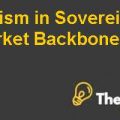
Porter’s Five Forces Model
Bargaining Power of Buyer: medicine is more like a commodity or necessity for people, and they do not bargain extensively on the prices and prefer the list price. The demand for many medicines around the globe is very high which is why the industry manufacturers set the prices freely. The patents on some major products also keep the manufacturer at advantage in setting the price, and people don’t get options, so their power to bargain remains low. Although the government can influence the prices, but the sizes of the pharmaceutical companies and their tendency of paying taxes regularly restrict the governments from doing. Governments get the medicines at the list price, but for the benefit of the people subsidize them.
Bargaining Power of Supplier: The industry has an open source of suppliers which keeps the suppliers power to bargain on a lower side. Companies usually prefer to outsource their activities as they have pre-determined firms having the competency for the assigned activity. Secondly, pharma companies place bulk orders, and the suppliers try to provide negotiated and competitive prices. Also, suppliers try to keep their big accounts and don’t prefer to threat much to the pharma companies and try to keep the flow of the industry.
Threat of Substitutes: The threat is at a lower or to be more precise medium as the products or medicines usually don’t have any other substitutes. With the introduction of generic medicines prescribed by many doctors, consumers got the benefit of buying generic brands as an alternative instead of buying expensive drugs or branded medicines. Also, the alternatives are present in the form of herbal medicines, and some major alternatives of few major diseases like AIDS are also available now.
Threat of New Entrant: The entry barriers are very complex in the industry and present a discouraging aspect for new entrants keeping the threat very low. The initial cost of setting up a manufacturing or the precise initial setup cost and capital is very high. There are certain costs in the industry that are excessive that includes research and development of new products, marketing and distribution cost and more importantly the manufacturing cost. On the other, the big names in the industry have a strong hold on every aspect of the industry, whether it is related to production or distribution. The presence of big players is also a discouraging factor as establishing into the market and gaining a market share will be a tough task. Also, some rules and regulations of the governments also favor the existence of big players in the market and restrict the entry of new players.
Competitive Rivalry: although the industry has only a few big players and each of them have a control over one segment, but still the overall rivalry in the industry is very competitive and intense. The big players contribute and collaborate to prevent the entry of new players, but on a bigger scale compete to gain a better and bigger market share. The overall industry is very attractive, so the players fight to get exclusivity for their products and medicines. On the other, the players collaborate in research and development and some medicines are due to collaborative efforts, but still the rivalry among big names remains high thus increasing the intensity of the competition.
Financial Ratios Analysis
The ratio analysis will highlight the position of Wyeth in terms of different ratios in order to make the decision criteria easy for Pfizer. All the calculations of the ratios are highlighted in exhibit 1 and explained in this portion. The current ratio suggests that the company Wyeth is highly capable of paying its debts easily and efficiently turning its products into cash. The current ratio of the company has increased from 3.14 to 3.42 showing a more positive sign. The company’s quick ratio is on a higher side, means that the company is keeping too much cash on hand and might face problems while collecting accounts receivable. On the other, it is also a positive sign as the company has enough cash to handle crisis situations. The company’s net working capital ratio is low which means that the company is quite capable of paying off its short-term liabilities.
The company’s net working capital ratio is growing not in a rapid pace, but still with continued growth in this ratio the company will be able to expand its operations in years to come. The net profit margin ratio is in a declining trend and also very low which means that the company is losing its efficiency of converting revenues into profits.............................
This is just a sample partial case solution. Please place the order on the website to order your own originally done case solution.











